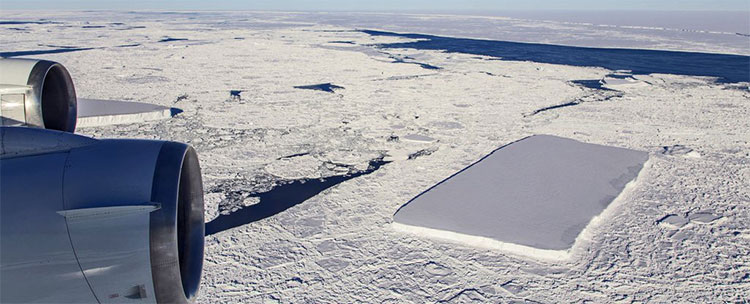What will happen to NASA's ever-hot rectangular iceberg?
Will the rectangular ice sheet permanently exist in Antarctica, or how will nature have treatment with it?
In mid-October 2018, NASA expert Jeremy Harbeck had a field flight at the Antarctic Peninsula. It was during this flight that he discovered a "strange" ice sheet, with a square rectangle shaped into a scene, as if someone's hand was embedded.
Despite its unusual appearance, this is a completely natural phenomenon. The name of this tape is "tabular iceberg", often separated from the eternal ice shelves, so it has a square appearance that is more sharp.
Will this ice be permanently shaped like that?
Recently, Sue Cook, an Antarctic ice researcher from the University of Tasmania (Australia), had an article on The Conversation about the story that will happen next with this perfect ice sheet.

Over time, ocean waves will gradually erode, creating deep dents on the side of the iceberg.
Based on the original images, Cook found that the ice was still square, straight and sharp, indicating that it was only formed. But over time, the waves will gradually erode, creating deep dents on the side of the iceberg.
The indentation deepens, the resistance of the iceberg decreases. To a certain extent, it will break and lose a large amount of tape from the edges, or break into smaller pieces.
However, this process does not happen overnight. The sea will bring icebergs along the Antarctic coast. Thanks to cold wind and low water temperature, the melting process is not fast, and a large ice sheet can last for decades.
The ice could be pushed into the northern sea, far from the Antarctic coast. In this case, it will be monitored by satellites provided by the US National Ice Center, avoiding the risk of crashing into boats.
The movement of ice is actually more important to science than you think. Not only because of ship safety, but also because ice will release fresh water and microorganisms into the ocean during the travel process. This changes the chemical composition of the water, affecting both the flow and the biological life of the area.
According to Sue Cook, the largest ice track that has been watched so far carries the B-15 number. It separated from Antarctica in 2000, and some of its fragments still exist near South Georgia Island and off New Zealand.
The reason B-15 survived for so long was because of its "massive" size - 295km long, 37km wide. And this ice sheet has a length and width of just over 1km, so its "life expectancy" is not too high. According to Cook's observation, the sea is rolling the ice around. When moving, that perfect shape will soon disappear.
However, the story is not only that. Cook said the iceberg is small but hidden behind it is a bigger problem. In July 2017, the nearby Larsen C ice shelf has lost a large amount of ice, making this area the smallest scale in human history.
In Antarctica, the frequency of iceberg creation is increasing, so the possibility of seeing another rectangular iceberg is small. Only thing, the more you see, the worse the story becomes.
- NASA announced the image of the ice floated square, never seen before
- The iceberg is about the size of Singapore
- Detect a rectangular galaxy
- Revealing the iceberg sank the legendary Titanic
- The coffin-shaped iceberg is about to disappear after 18 years
- Why are fresh water cans round and not rectangular?
- 4 scenario is happening when the largest iceberg in history has just broken in Antarctica
- Marvel at the beautiful blue iceberg
- I finally understood why the circular smartphone camera lens took a rectangular image
- Ice floats 11 million tons
- Discover the giant 'iceberg city' in Antarctica
- The ice is four times bigger than London is heading to the sea
 'Fine laughs' - Scary and painful torture in ancient times
'Fine laughs' - Scary and painful torture in ancient times The sequence of numbers 142857 of the Egyptian pyramids is known as the strangest number in the world - Why?
The sequence of numbers 142857 of the Egyptian pyramids is known as the strangest number in the world - Why? History of the iron
History of the iron What is alum?
What is alum?